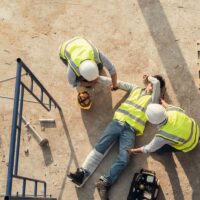How Does New York’s Scaffold Law Affect a Construction Accident Case?

Construction work is inherently dangerous, but accidents can be greatly reduced or even eliminated when owners, developers and contractors take reasonable steps to ensure a safe environment. Construction is never-ending in New York, and the city has some of the strictest laws you’ll find anywhere when it comes to making sure construction workers have a safe place to work.
One of the most significant statutes protecting construction workers in New York is the Scaffold Law, found in New York Labor Law § 240(1)/241. This law plays a crucial role in assigning liability after a construction accident, particularly those involving falls from heights or injuries caused by falling objects. Read on as we discuss the role of the Scaffold Law in New York construction accident cases. If you or a family member has been hurt in an NYC construction accident, contact Leandros A. Vrionedes, P.C., for guidance and help from an experienced and successful New York City construction accident lawyer.
The Scaffold Law Explained
The Scaffold Law, established in 1885, is designed to protect construction workers by placing absolute liability on property owners and general contractors for elevation-related injuries. The law requires that scaffolding, ladders, and other devices be constructed, placed, and operated to give proper protection to workers. If an injury occurs due to a violation of this requirement, the property owner and contractors can be held liable, regardless of whether they were directly supervising the work.
Key provisions of the Scaffold Law include:
- Strict Liability: Unlike other personal injury cases, where the injured party must prove negligence, the Scaffold Law imposes strict liability on property owners and contractors. This means that if a worker is injured due to a fall from an elevation or by a falling object, the property owner and contractors are automatically considered liable if the safety provisions were not met.
- Protection from Contributory Negligence: In contrast to other personal injury claims, a worker’s own negligence that contributed to the accident or injury will not bar a claim or result in a proportionate reduction in the amount the injured worker can recover. Instead, the focus is on whether the safety devices were adequate and properly provided.
- Scope of Protection: The law applies to a wide range of activities, including construction, demolition, repair, alteration, painting, cleaning, and pointing of buildings or structures.
Impact on Construction Accident Cases
Increased Responsibility for Safety
The Scaffold Law incentivizes property owners and contractors to maintain high safety standards on construction sites. They must ensure that all safety devices are properly installed and that workers are trained in their use. Failure to adhere to these standards can result in severe financial liability. Even though accidents still happen, the Scaffold Law is recognized as leading to increased responsibility for safety on construction sites.
Legal Recourse for Injured Workers
For construction workers injured in elevation-related accidents, the Scaffold Law provides a powerful legal tool. Injured workers can file a lawsuit against the property owner and contractors without the burden of proving negligence. This simplifies the legal process and increases the likelihood of obtaining compensation for medical expenses, lost wages, and pain and suffering.
Higher Settlements and Awards
Due to the strict liability nature of the Scaffold Law, settlements and awards in construction accident cases tend to be higher. The certainty of liability encourages property owners and contractors to settle claims more readily, often resulting in more favorable outcomes for injured workers.
Challenges and Criticisms
While the Scaffold Law provides significant protection for workers, it has faced criticism, particularly from property owners and contractors. They argue that the law leads to increased insurance costs and discourages investment in construction projects. However, proponents of the law contend that it is essential for ensuring worker safety in a high-risk industry.
How Leandros A. Vrionedes, P.C. Can Help
At Leandros A. Vrionedes, P.C., we understand the complexities of construction accident cases and the critical role the Scaffold Law plays in securing justice for injured workers. Our experienced legal team is dedicated to advocating for your rights and ensuring you receive the compensation you deserve. We meticulously investigate each case to establish liability and demonstrate how safety standards were breached.
If you or a loved one has been injured in a New York City construction accident, don’t navigate the legal system alone. Call Leandros A. Vrionedes, P.C. today at 212-889-9362 for a free consultation. Let us help you understand your rights under the Scaffold Law and guide you through the process of obtaining the compensation you need to recover and move forward with your life.


